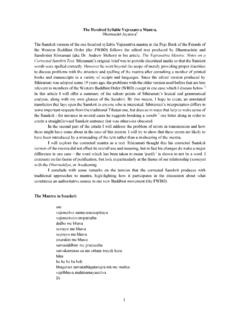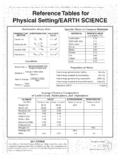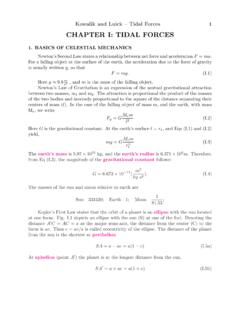Transcription of The Origin of Buddhist Meditation 2 - Western Buddhist …
1 1 Review: The Origin of Buddhist Meditation by Alexander Wynne The Origin of Buddhist Meditation by Alexander Wynne London & New York: Routledge, 2007, 192 pages, ISBN 978-0-415-42387-8, UK (h/b), Reviewed by Vishvapani ( ) Abstract: The Origin of Buddhist Meditation by Alexander Wynne analyses the Ariyapariyesana Sutta s account of the Buddha s study under his two Meditation teachers. He concludes that they were historical persons, that they taught the Buddha practices that are described in certain Brahmanical texts, and that, while the Buddha rejected the teachers views of liberation, vestiges of their influence are evident in his later teaching.
2 This short but densely written book proposes a method for ascertaining the veracity of Pali texts and draws conclusions about the Buddha s teaching and his religious environment. What, if anything, do we know about the Buddha? In addition to its importance for Buddhist studies, this question is or at least should be of fundamental interest to those who consider themselves the Buddha s followers. But scholars have grown increasingly sceptical of efforts to find solid information about the Buddha s life and teachings in the early texts and some consider the whole project an orientalist and essentialist attempt to construct a portrait of the Buddha according to Western biases.
3 Such readers often regard the suttas/sutras of the early canon as literary fabrications designed by their compilers to serve polemical ends, rather than as sources of reliable historical information. Notwithstanding these trends, in The Origin of Buddhist Meditation Alexander Wynne engages with admirable vigour in the task of wresting such information from the suttas. Like other volumes in the Routledge Critical Studies in Buddhism series, this book started life as a doctoral thesis and these origins Vishvapani, Review: The Origin of Buddhist Meditation are manifest in the narrowness of Wynne s focus and his fondness for convoluted philological analysis.
4 But this book differs from most theses in the ambition of the conclusions at which it aims. Wynne believes that if he can establish the veracity of key incidents in the Buddha s life he can make further reliable deductions about the Buddha s life, his teachings, his relationship to other religious traditions and his approach to Meditation . While the book may not accomplish everything it claims it is a tour de force of textual scrutiny and polemical rigour. Wynne s principal focus is the well-known account in the Ariyapariyesana Sutta of the Bodhisattva s study under two Meditation teachers: Alara Kalama, who reportedly taught him to attain the sphere of nothingness , and Uddaka Ramaputta, who guided him towards the sphere of neither-perception-nor-non-perception.
5 To establish the text s veracity Wynne notes the circumstantial evidence of anomalies and quirks within it for which the best explanation is that they record actual events. For example, he notes a hint in the text which shows that the sphere of neither-perception-nor-non-perception was attained not by Ramaputta but by his teacher, Rama. This is hardly an important discovery, and other scholars have noted it previously; but Wynne s point is that the only convincing explanation for the presence of this detail which serves no polemical purpose and which later Buddhist tradition forgot is that it records a real fact about a real person.
6 Thus, Wynne argues, in combination with similar pieces of evidence, we can deduce that it is overwhelmingly likely that the two teachers really did exist. This circumstantial evidence is not definite proof, but in the fog of early Indian history where Brahmanical and Jain texts are even less reliable than Buddhist ones and archaeology adds little to our knowledge of the Buddha even this is a significant contribution. Wynne s method, which focuses on tiny details, can seem pedantic but it is an ingenious way of addressing the problems that have often stymied efforts to trace Buddhist texts back to the Buddha himself.
7 Having concluded that Alara Kalama and Uddaka Ramaputta were historical persons Wynne attempts to place them in their religious context by finding Western Buddhist Review, Vol. 5 3 parallels in Brahmanical texts to the meditative goals they taught, drawing especially on some of the Upanishads and the Mokshadharma chapter of the Mahabharata. In doing so he is also attempting to identify the religious traditions and views to which the Bodhisattva was exposed in the course of his training. The spheres of nothingness and neither-perception-nor-non-perception are familiar within Buddhism as the third and fourth of the arupa, or formless, dhyanas that is, as elevated but nonetheless mundane states of consciousness.
8 But in the Brahmanical texts cited by Wynne they constitute an ultimate reality brahman. According to these sources, existence devolved from brahman into the six elements that comprise the universe and formed consciousness, then space and then air, fire, water and earth. The meditating yogi first identifies with and then dissolves each of the elements in turn, thereby ascending through them and reversing the process of creation. Ultimately he achieves union with brahman. Alara Kalama identified this with the meditative state called the sphere of nothingness while Uddaka Ramaputta placed it in the sphere of neither-perception-nor-non-perception.
9 Wynne strengthens his argument that the Bodhisattva trained in these traditions by identifying apparently anomalous aspects of the Buddha s mature teachings. For example, Buddhist Meditation on the elements has no theoretical foundation in Buddhist cosmology, and Wynne concludes the Buddha had learned it from the two teachers and was happy to teach it himself. Wynne also undertakes a detailed analysis of the Buddha s dialogue with the Brahmin Upasiva in the Pariyayavagga of the Sutta Nipata and shows that Upasiva understands the goal of Meditation in terms of the practices that Alara Kalama taught, that the Buddha knows what he is referring to and that he is willing to use language with which Upasiva is familiar for the sake of communicating with him.
10 But the Buddha then subverts Upasiva s understanding by stressing that, far from merging him-or-herself with the sphere of nothingness, the meditator should remain mindful even while dwelling within it. Vishvapani, Review: The Origin of Buddhist Meditation The Buddha s concern in his Meditation teaching was not the cosmological significance of a particular meditative state but the meditator s attitude towards it. Extending this point, Wynne suggests that the arupa dhyanas, which are defined in cosmological terms, are themselves a vestige of the Buddha s Brahmanical training and have been rather unsatisfactorily appended to the list of the rupa dhyanas.







